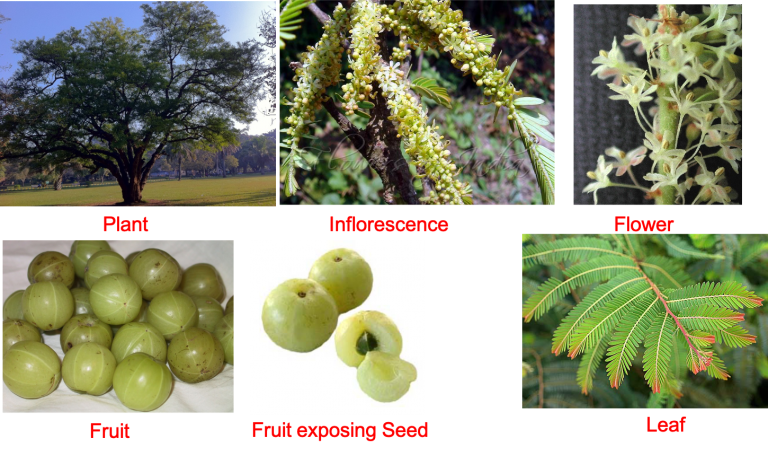AMALAKI
- Home / DRAVYAGUNA (AYURVEDIC PHARMACOLOGY) / / KNOW ABOUT MEDICINAL PLANTS / / AYURVEDIC MEDICINAL PLANTS /
- AMALAKI
Who doesn’t know about the plant Amalaki? It is a plant whose fruits are the most relishable one. It is supposed to have originated in the South-eastern Asia. Ayurveda, considers it as one of the most important nutritive plant. This consideration is so much that Charaka has dedicated a portion of the chapter in the Chikitsa Sthana of Charaka Samhita. The fruits of the plant is a valuable medicine and is an ingredient in many formulation of Ayurveda including the most famous CHYAVANAPRASHA. Its multidimensional medicinal benefits have resulted in its profuse use in different formulations of Ayurveda concerning with almost every part of the body. The botanical name of the plant is Emblica officinalis Gaertn. The name Emblica is the latinised sanskrit name meaning sour juice while officinalis is a latin word that means the officially used or in the service of humans. The plant occurs wild and cultivated in the tropical and subtropical parts of India. It is also found in these regions around the world.
PLANT DETAILS
BOTANICAL NAME
Emblica officinalis Gaertn or Phyllanthus emblica Linn
FAMILY
Phyllanthaceae
NOMENCLATURE
VERNACULAR NAMES
- Kannada – Nellikayi
- Malayalam – Nelli
- Tamil – Nellikayi
- Telugu – Usiri, Usirikayi
- Hindi – Amla
- English – Indian gooseberry or Embelic myrobalan
SANSKRIT SYNONYMS
- अमृत (Amruta) – Is beneficial like nectar and postpones ageing
- धात्री (Dhatri) – is mother or foster-mother in Sanskrit. Hence the fruit takes care of us like mother
- श्रीफल (Shriphala) – Highly beneficial fruit
- शीत (Sheeta) – Has a soothing potency
- त्रिष्यफल (Tishyaphala) – The fruit is demarcated with three lines
- आमलक (Amalaka) – A sour tasting fruit
- शिव (Shiva) – A very auspicious and favourable
SAMHITA CLASSIFICATION
- Charaka Samhita – वयस्थापन (Vayasthapana) & विरेचनोपग (Virechanopaga).
- Sushruta Samhita – त्रिफल (Triphala) & परूषकादि (Parushakadi).
NIGHANTU CLASSIFICATION
- Dhanvantari Nighantu – Chandanadi Varga
- Bhavaprakasha Nighantu – Hareetakyadi Varga
- Raja Nighantu – Amradi Varga
- Kaiyadeva Nighantu – Aushadhi Varga
BRIEF MORPHOLOGY
A medium sized deciduous tree, curved trunk with light grey or white bark either peeling that is small or irregular. The leaves are in small lateral twigs that range from 2 to 4 cms. The leaves are attached in two rows on each side of this branchlet which gives a compound leaf like appearance. Leaves are simple, appears like tamarind leaflets thin and small, closely set. Inflorescence is axillary fascicles belonging to the category of cymose corymb. The flowers are unisexual, greenish yellow in colour. male flowers numerous, slightly pedicellate, female are few, sessile. Fruits are globose, smooth, fleshy, green coloured, 1.5 to 2.5 cms in diameter with six lobes with 6 seeds encased in a hard endocarp called as Stone. The mesocarp is the edible part of the fruit.
PHARMACOGNOSY OF OFFICIAL PART
MACROSCOPY
YET TO BE COMPILED
MICROSCOPY
YET TO BE COMPILED
PART USED AND POSOLOGY
PART USED
फल (Fruits), पत्र (Leaves), बीज (Seeds or Stone)
DOSE
चूर्ण (Powder) – 5 to 6 gms स्वरस (Juice) – 12ml.
PHYTOCHEMISTRY
The fruits are a rich source of Vitamin C. Along with the fruit, leaves and bark contain tannins, gallic acid, resinous matter, minerals, glucose, etc. The fruit also contains chebulagic acid, gallic acid, hydrolysable tannins like emblicanin A and B, flavanoids like quercetin, alkaloids like phyllantidine and phylladine, etc.It also contains high concnetration of proteins, minerals and aminoacids.
रसपञ्चक कर्म PROPERTIES AND USES AS PER AYURVEDA
गुण (Properties)
- रस (Rasa) – अम्ल प्रधान लवण वर्जित पञ्चरस (Amla predominated 5 Rasa excluding Lavana)
- गुण (Guna) – लघु (Laghu), रूक्ष (Ruksha), शीत (Sheeta)
- वीर्य (Veerya) – शीत (Sheeta)
- विपाक (Vipaka) – मधुर (Madhura)
- प्रभाव – None
कर्म & प्रयोग (Action & Indications)
- दोषकर्म (Doshakarma) – त्रिदौषहर (Tridoshahara) predominantly पित्तहर (Pittahara)
- धातुकर्म & मलकर्म (Dhatukarma and Malakarma) – Main actions – रसायन, वृष्य, रुचिकर, श्रमहर, केश्य, दाहप्रशमन, संधानीय, स्वेदहर, शुक्रल (Rasayana, Vrishya, Ruchikara, Shramahara, Keshya, Dahaprashamana, Sandhaneeya, Swedahara, Shukrala)
- Other Actions – मेध्य, रोचन, दीपन, अनुलोमन, मूत्रल, हृद्य, चक्षुष्य (Medhya, Rochana, Deepana, Anulomana, Mutrala, Hridya, Chakshushya)
- प्रयोग (Prayoga) – Mainly वमी, शोफ, विबन्ध, आध्मान, विष्टम्भ, प्रमेह, पिपास, भग्न (Vami, Shopha, Vibandha, Adhmana, Vishtambha, Prameha, Pipasa, Bhagna) also useful in नाडीदौर्बल्य, दृष्टिदौर्बल्य, अम्लपित्त, गुल्म, कास, श्वास, सोमरोग, etc (Nadidaurbalya, Drishtidaurbalya, Amlapitta, Gulma, Kasa, Shwasa, Somaroga, etc)
AYURVEDIC FORMULATIONS
CLASSICAL
- त्रिफल
- ब्रह्मरसायन
- च्यवनप्राश
- भृङ्गामलक तैल
- त्रिफलादि तैल
- आमलकावलेह
- All formulations where Triphala is a ingredient
PROPRIETARY
- Amla caplets
- Amla Juice
- Herbal Max amla extract Capsule
- Diabex
AGRONOMY
ENVIRONMENT
The plant grows at an altitude upto 2000 meters above sea level. The best suited climate is deciduous, moist and hot forests with an annual rainfall of 630-800mm. The preferred climate is arid or semi-arid conditions.
CULTIVATION
The plant grows well in sandy loam or clayey soil with a slightly acidic or alkaline pH. Sandy soils is advised to be avoided for the purpose. The soil should be deep, fertile and well drained. Young shoots are sensitive while the mature plants can tolerate the temperatures from 3 to 46 degree Centigrade. The plant can be grown from seeds or though grafting methods. Around 200 plants can be planted per acre
HARVESTING
Harvesting of the fruits can be done after 2 years of planting and a well maintained tree will be giving fruits for around 70 years. A mature tree of 10 years can produce upto 50 to 70 kgs of fruit.
STORAGE
The fruits are highly perishable ones hence, naturally it gets decayed. Thus, it is usually advised to store in cold storages and controlled atmosphereic storages. Other than these, the fruits are dried in sunshade and are preserved.It can also be processed into juice and other preparations to serve the purpose.
VARIETIES AND SUBSTITUTES OR ADULTERANTS
VARIETIES
General classification it is of two types namely
- वन्य (Wild)
- ग्राम्य (Cultivated)
ADULTERANTS
NO KNOWN ADULTERANTS
SUBSTITUTES
NO KNOWN SUBSTITUTES
TOXICITY
TOXIC SYMPTOMS
- As such there is no proved toxicity of the plant.
ANTIDOTE
- Not Applicable as such.
शोधन or PURIFICATION METHOD
- NOT NECESSARY
THERAPEUTIC USES
EXTERNAL USES –
The powder, decoction or even pastes of the dried fruits are used for wash especially for hairs. The paste is also applied over the head or the affected part to treat diseases of head, hair, scalp and skin. Fruits kept over night duly soaked in water (Hima preparation) is used for washing the eyes. To treat headache with a feeling of burning or fuming, the paste is applied over the head. The juice extracted from the leaf is used as eyedrops to treat eye disorders. Ointment prepared from the ash of burnt seeds after suspending it in oil is useful in the treatment of scabies and other skin infections.
INTERNAL USES –
Internally the fruits have a good range of use from food to medicine. The fruits are pricked with sterile needles and immersed in thick syrup till it absorbs the syrup. This preparation is known as Murabba. The powder of the fruit is given with honey to treat worm infestation. The fresh juice of the fruit is given internally to treat different bilious conditions. The seeds powder is given internally to treat leucorrhoea. Fresh Amla juice is also given internally to control dysuria, epistaxis, piles, etc. The powder of the fruit along with turmeric is useful in the treatment of diabetes.
CONTROVERSY (IF PRESENT)
YET TO BE COMPILED
LIST OF RESEARCH STUDIES
- Kumar V, Aneesh KA, Kshemada K, et al. Amalaki rasayana, a traditional Indian drug enhances cardiac mitochondrial and contractile functions and improves cardiac function in rats with hypertrophy. Sci Rep. 2017;7(1):8588. Published 2017 Aug 17.
- Dr. Pravin M Bhat, Dr. Hari Umale and Dr. Madhukar Lahankar. Amalaki: A review on functional and pharmacological properties. Journal of Pharmacognosy and Phytochemistry 2019; 8(3): 4378-4382
- Dr. Ketan Rathwa, Dr. Rakesh Salve. PHARMACOGNOSTICAL STUDY OF AMALAKI (EMBLICA OFFICINALIS GAERTN.). European Journal of Biomedical AND Pharmaceutical sciences. 2018, Volume 5, Issue 7, 764-766.
The video on Amalaki emphasises on the various aspects of the plant especially with respect to its cultivation and its characteristics for identification such that they are preserved for the future generations.



